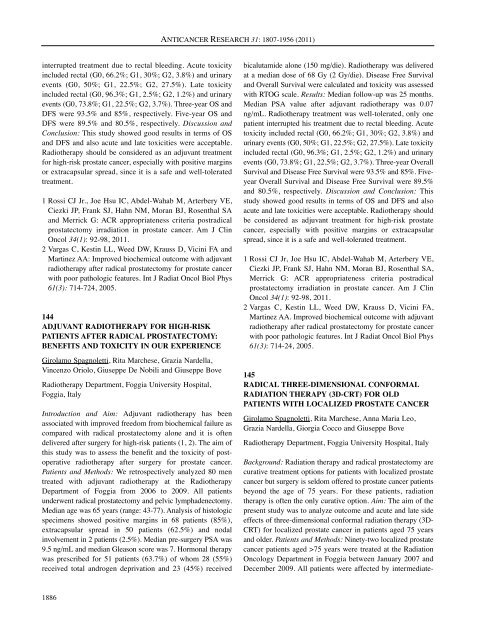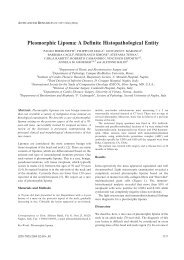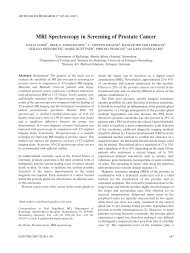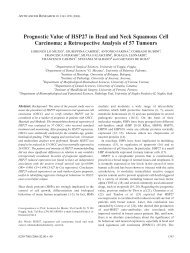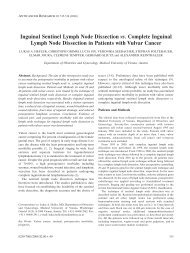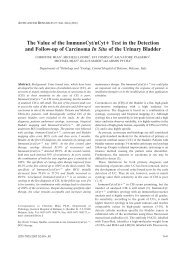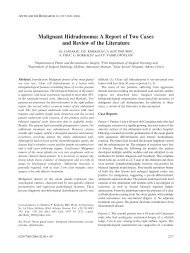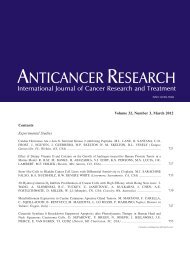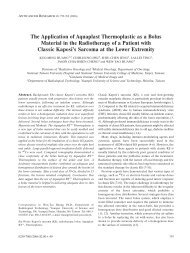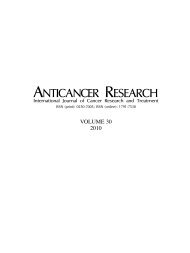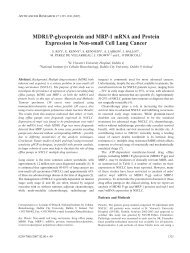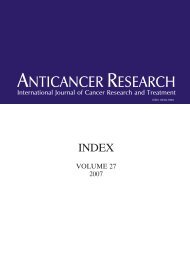ABSTRACTS OF THE 21st ANNUAL MEETING OF THE ITALIAN ...
ABSTRACTS OF THE 21st ANNUAL MEETING OF THE ITALIAN ...
ABSTRACTS OF THE 21st ANNUAL MEETING OF THE ITALIAN ...
Create successful ePaper yourself
Turn your PDF publications into a flip-book with our unique Google optimized e-Paper software.
interrupted treatment due to rectal bleeding. Acute toxicity<br />
included rectal (G0, 66.2%; G1, 30%; G2, 3.8%) and urinary<br />
events (G0, 50%; G1, 22.5%; G2, 27.5%). Late toxicity<br />
included rectal (G0, 96.3%; G1, 2.5%; G2, 1.2%) and urinary<br />
events (G0, 73.8%; G1, 22.5%; G2, 3.7%). Three-year OS and<br />
DFS were 93.5% and 85%, respectively. Five-year OS and<br />
DFS were 89.5% and 80.5%, respectively. Discussion and<br />
Conclusion: This study showed good results in terms of OS<br />
and DFS and also acute and late toxicities were acceptable.<br />
Radiotherapy should be considered as an adjuvant treatment<br />
for high-risk prostate cancer, especially with positive margins<br />
or extracapsular spread, since it is a safe and well-tolerated<br />
treatment.<br />
1 Rossi CJ Jr., Joe Hsu IC, Abdel-Wahab M, Arterbery VE,<br />
Ciezki JP, Frank SJ, Hahn NM, Moran BJ, Rosenthal SA<br />
and Merrick G: ACR appropriateness criteria postradical<br />
prostatectomy irradiation in prostate cancer. Am J Clin<br />
Oncol 34(1): 92-98, 2011.<br />
2 Vargas C, Kestin LL, Weed DW, Krauss D, Vicini FA and<br />
Martinez AA: Improved biochemical outcome with adjuvant<br />
radiotherapy after radical prostatectomy for prostate cancer<br />
with poor pathologic features. Int J Radiat Oncol Biol Phys<br />
61(3): 714-724, 2005.<br />
144<br />
ADJUVANT RADIO<strong>THE</strong>RAPY FOR HIGH-RISK<br />
PATIENTS AFTER RADICAL PROSTATECTOMY:<br />
BENEFITS AND TOXICITY IN OUR EXPERIENCE<br />
Girolamo Spagnoletti, Rita Marchese, Grazia Nardella,<br />
Vincenzo Oriolo, Giuseppe De Nobili and Giuseppe Bove<br />
Radiotherapy Department, Foggia University Hospital,<br />
Foggia, Italy<br />
Introduction and Aim: Adjuvant radiotherapy has been<br />
associated with improved freedom from biochemical failure as<br />
compared with radical prostatectomy alone and it is often<br />
delivered after surgery for high-risk patients (1, 2). The aim of<br />
this study was to assess the benefit and the toxicity of postoperative<br />
radiotherapy after surgery for prostate cancer.<br />
Patients and Methods: We retrospectively analyzed 80 men<br />
treated with adjuvant radiotherapy at the Radiotherapy<br />
Department of Foggia from 2006 to 2009. All patients<br />
underwent radical prostatectomy and pelvic lymphadenectomy.<br />
Median age was 65 years (range: 43-77). Analysis of histologic<br />
specimens showed positive margins in 68 patients (85%),<br />
extracapsular spread in 50 patients (62.5%) and nodal<br />
involvement in 2 patients (2.5%). Median pre-surgery PSA was<br />
9.5 ng/mL and median Gleason score was 7. Hormonal therapy<br />
was prescribed for 51 patients (63.7%) of whom 28 (55%)<br />
received total androgen deprivation and 23 (45%) received<br />
1886<br />
ANTICANCER RESEARCH 31: 1807-1956 (2011)<br />
bicalutamide alone (150 mg/die). Radiotherapy was delivered<br />
at a median dose of 68 Gy (2 Gy/die). Disease Free Survival<br />
and Overall Survival were calculated and toxicity was assessed<br />
with RTOG scale. Results: Median follow-up was 25 months.<br />
Median PSA value after adjuvant radiotherapy was 0.07<br />
ng/mL. Radiotherapy treatment was well-tolerated, only one<br />
patient interrupted his treatment due to rectal bleeding. Acute<br />
toxicity included rectal (G0, 66.2%; G1, 30%; G2, 3.8%) and<br />
urinary events (G0, 50%; G1, 22.5%; G2, 27.5%). Late toxicity<br />
included rectal (G0, 96.3%; G1, 2.5%; G2, 1.2%) and urinary<br />
events (G0, 73.8%; G1, 22.5%; G2, 3.7%). Three-year Overall<br />
Survival and Disease Free Survival were 93.5% and 85%. Fiveyear<br />
Overall Survival and Disease Free Survival were 89.5%<br />
and 80.5%, respectively. Discussion and Conclusion: This<br />
study showed good results in terms of OS and DFS and also<br />
acute and late toxicities were acceptable. Radiotherapy should<br />
be considered as adjuvant treatment for high-risk prostate<br />
cancer, especially with positive margins or extracapsular<br />
spread, since it is a safe and well-tolerated treatment.<br />
1 Rossi CJ Jr, Joe Hsu IC, Abdel-Wahab M, Arterbery VE,<br />
Ciezki JP, Frank SJ, Hahn NM, Moran BJ, Rosenthal SA,<br />
Merrick G: ACR appropriateness criteria postradical<br />
prostatectomy irradiation in prostate cancer. Am J Clin<br />
Oncol 34(1): 92-98, 2011.<br />
2 Vargas C, Kestin LL, Weed DW, Krauss D, Vicini FA,<br />
Martinez AA. Improved biochemical outcome with adjuvant<br />
radiotherapy after radical prostatectomy for prostate cancer<br />
with poor pathologic features. Int J Radiat Oncol Biol Phys<br />
61(3): 714-24, 2005.<br />
145<br />
RADICAL THREE-DIMENSIONAL CONFORMAL<br />
RADIATION <strong>THE</strong>RAPY (3D-CRT) FOR OLD<br />
PATIENTS WITH LOCALIZED PROSTATE CANCER<br />
Girolamo Spagnoletti, Rita Marchese, Anna Maria Leo,<br />
Grazia Nardella, Giorgia Cocco and Giuseppe Bove<br />
Radiotherapy Department, Foggia University Hospital, Italy<br />
Background: Radiation therapy and radical prostatectomy are<br />
curative treatment options for patients with localized prostate<br />
cancer but surgery is seldom offered to prostate cancer patients<br />
beyond the age of 75 years. For these patients, radiation<br />
therapy is often the only curative option. Aim: The aim of the<br />
present study was to analyze outcome and acute and late side<br />
effects of three-dimensional conformal radiation therapy (3D-<br />
CRT) for localized prostate cancer in patients aged 75 years<br />
and older. Patients and Methods: Ninety-two localized prostate<br />
cancer patients aged >75 years were treated at the Radiation<br />
Oncology Department in Foggia between January 2007 and<br />
December 2009. All patients were affected by intermediate-


